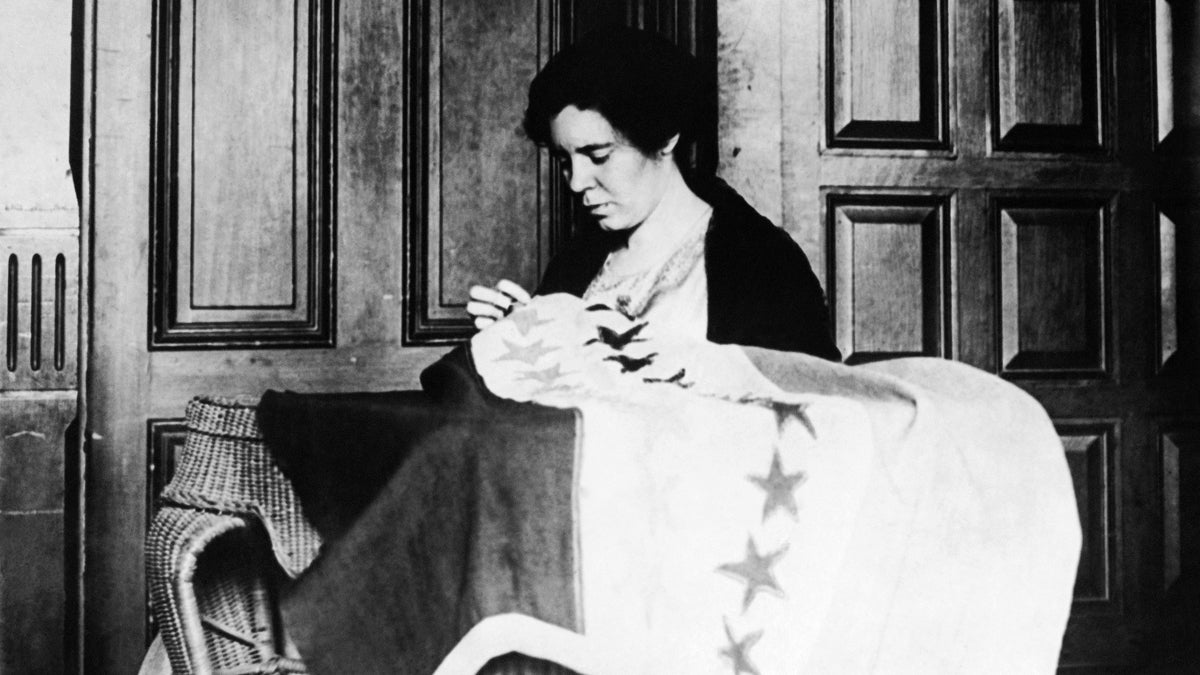‘Remember the ladies’ of the 19th Amendment
Listen
Alice Paul, chairwoman of the Nation Women's Party, takes up needle and thread to put the last stitch in the suffrage banner (c. 1932) which now has 36 stars representing the 36 states that ratified the 19th Amendment. (AP Photo)
“Remember the ladies” is the message Abigail Adams urged on her husband, John Adams, as he sat in the Continental Congress in 1776, deciding upon the course for a new nation.
But the ladies were not remembered in 1776 in the Declaration of Independence, nor in 1787 with the adoption of the new country’s constitution, nor when the 15th Amendment was adopted in 1870 granting the right to vote to all “citizens” (read: men) regardless of “race, color or previous condition of servitude.”
The “ladies” finally took matters into their own hands.
As we observe Constitution Day on Sept. 17, it behooves us to “remember the ladies” who struggled, marched, and even went to jail to obtain this most basic civil right for the women of America.
Today, Susan B. Anthony is probably the best-known American suffragist. After all, she has a U.S. dollar coin in her honor. Remember that?
She and her suffragist sisters Elizabeth Cady Stanton, Lucretia Mott and Lucy Stone campaigned tirelessly throughout the second half of the 19th century for women’s right to vote.
But by 1900, women had the vote in only four western states. By 1910, the movement for national women’s suffrage had stalled.
It took a slight, quiet Quaker woman from New Jersey to turn up the heat.
Enter Alice Paul
In March 1913, 28 year-old Alice Paul organized a public march in Washington, D.C., for the day before President Woodrow Wilson’s first inauguration. More than 8,000 women and men paraded down Pennsylvania Avenue behind a yellow banner declaring, “We Demand an Amendment to the Constitution of the United States Enfranchising the Women of this Country.”
Many in the crowd of more than 250,000 mostly men, became ugly, grabbing banners, toppling floats and spitting on, pinching and groping female marchers. The police did nothing, and the federal cavalry had to be called to restore order in the city.
Neither did the suffragists hesitate to embarrass President Wilson. During a 1914 presidential speech to Congress, Paul’s suffragists unfurled a banner from the front row of the visitors’ gallery, reading, “Mr. Wilson, what are you doing for women’s suffrage?”
In January 1917, Paul took her fight to the gates of the White House, becoming the first protestor to do so. Paul and her “Silent Sentinels” maintained an almost constant vigil for 18 months in front of the White House.
In June 1917, the White House picketers greeted a visiting Russian delegation with signs that read, “Tell our government that it must liberate its women before it can claim free Russia as an ally.” After this so-called “Russian Incident,” the White House changed its laissez-faire attitude towards the suffrage picketers and the first arrests were made for “obstructing traffic.”
A hunger for equality, a test of endurance
Silent Sentinels continued to be arrested and, after refusing to pay their fines, women were jailed with longer and longer sentences imposed. The treatment of the jailed suffragists went from bad to worse.
On November 15, 1917, suffragists endured what was later called the Night of Terror at Occoquan Workhouse. Under orders from the superintendent, guards with clubs brutalized 33 jailed suffragists. They beat Lucy Burns and chained her hands to the cell bars above her head. They hurled Dora Lewis into a dark cell, smashing her head against an iron bed which knocked her out cold. Women were grabbed, dragged, beaten and choked.
Finally, in jail with the others, Paul decided to implement a strategy she had learned in England — the hunger strike — refusing to eat as a protest of their detention. Prison officials responded by force-feeding the hunger strikers through nasal tubes, forcibly inserted. Paul herself was held in solitary confinement and even placed in a psychiatric ward.
Suffrage supporters were able to turn the barbaric treatment of Paul and the other jailed suffragists into sympathy for their cause and embarrassment for President Wilson. Finally, Wilson announced his support for the federal suffrage amendment to the U.S. Constitution. With his support, Congress passed the amendment in June 1919, and it was ratified and signed into law on August 26, 1920.
It seems inconceivable to us today that women would not have the right to vote, to control their own wages, to own property in their own names or to be admitted on equal terms to schools, jobs and professions. But without the struggle, perseverance, suffering and dedication of Alice Paul and her fellow suffragists, it might have taken much longer to obtain these rights.
And so, we honor and “Remember the Ladies.”
—
Beth Olanoff is program director of Vision 2020, Institute for Women’s Health and Leadership, Drexel University College of Medicine.
WHYY is your source for fact-based, in-depth journalism and information. As a nonprofit organization, we rely on financial support from readers like you. Please give today.

